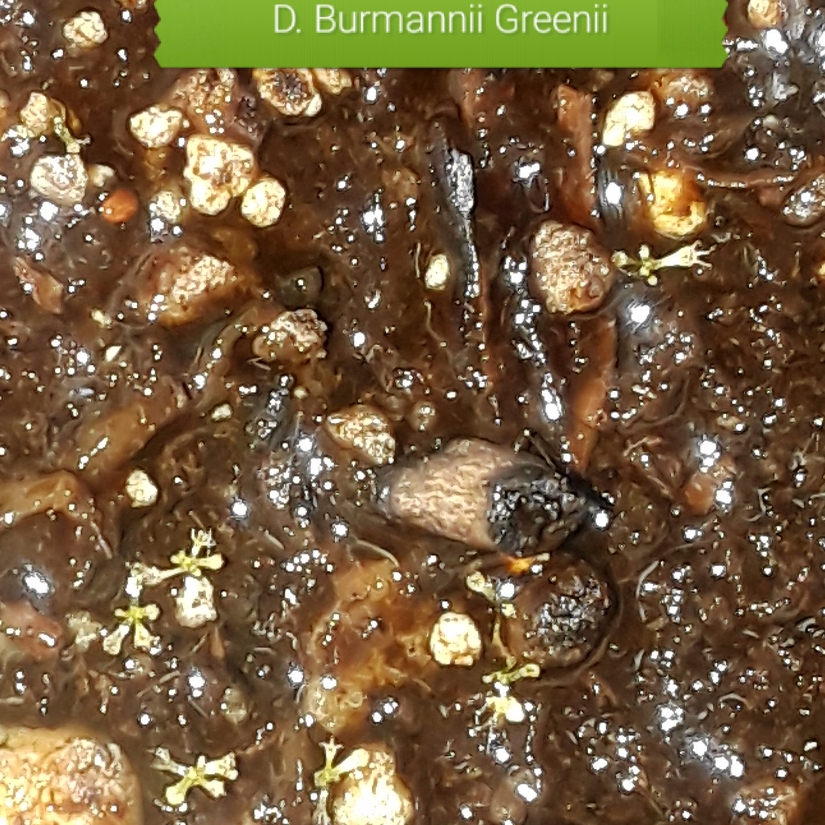
Drosera Burmannii Green
Drosera Burmannii Green
Drosera burmannii -The Burmese SundewDrosera burmannii is a great sundew for beginners. This compact rosetted sundew can be found in Southeast Asia and parts of Australia, in subtropical climates. Media: I normally use 1:1 peat: sand (silica), but you can use pretty much anything if you feed it enough. Small amounts of perlite can be added. I have also used ground live sphagnum with a little sand and perlite, and they have grown very well. Be sure to rinse your media before using it. Media moisture: keep moist. Drosera burmannii isn't picky, but don't let the soil get too dry in elevated temperatures. Humidity: very little is needed with the tray method, as long as there is little or no air movement. Pot height: ~3 inches or taller. Not picky. Trapping speed: D. burmannii is one of the fastest-trapping sundews. (either 2nd or 3rd fastest behind D. glanduligera). If there is movement on its snap tentacles, they will fold down within a few seconds. Feeding: If fed every 2 weeks or more, Drosera burmannii grows large, and at a rapid pace. See feeding page. Feeding also encourages profuse flowering. If growing D. burmannii outdoors, manual feeding is not usually necessary. Food size: can handle any amount of food. I've fed mine large slugs -that were growing in my pot :(- they ate them with no problem. Plant dimensions: if fed only a little, or overcrowded, D. burmannii will usually remain dime to nickel-sized. If fed often, can get over 1.5 inches across (larger than an Eisenhower coin). Some forms are capable of getting even larger than this. Temperature: Can handle warm temperatures if grown outdoors, but mine started to decline when temperatures climbed above 85 F indoors. Give subtropical conditions. Lighting/Photoperiod: Drosera burmannii prefers as much light as possible. When fed very little, Drosera burmannii can develop red or pink coloration on the tentacles. Some forms can turn completely red. If fed a lot, Drosera burmannii will grow rapidly and turn light green. Dormancy requirements: None. Drosera burmannii is normally an annual in nature, but if grown indoors during the colder months under lights, it can grow virtually forever. It will tend to die off after flowering it is not fed again. Flowers: Flowering WILL NOT cause Drosera burmannii to die UNLESS conditions are unfavorable. Keep temps in the recommended range, and feed often. Flowers self-pollinate on their own, very readily. Drosera burmannii produces around 20-30 flowers per stalk if fed a lot. Flowers are small and open for only a short time. Seed will start falling out of the pods within a few weeks from flowering.
Contributed by @PunkyKy
-
Full sun
-
Frequent watering
-
Not Frost hardy
-
Moist and free draining
Common name
Drosera Burmannii Green
Latin name
Drosera Burmannii Green
type
Carnivorous plant
family
Droseraceae
ph
3.0 - 8.0 Acid - Neutral
Plant & bloom calendar
-
Best time to plant
full grown dimensions
 0.00 M
0.00 M
0.00 M
0.00 M
Drosera Burmannii Green
Drosera burmannii -The Burmese SundewDrosera burmannii is a great sundew for beginners. This compact rosetted sundew can be found in Southeast Asia and parts of Australia, in subtropical climates. Media: I normally use 1:1 peat: sand (silica), but you can use pretty much anything if you feed it enough. Small amounts of perlite can be added. I have also used ground live sphagnum with a little sand and perlite, and they have grown very well. Be sure to rinse your media before using it. Media moisture: keep moist. Drosera burmannii isn't picky, but don't let the soil get too dry in elevated temperatures. Humidity: very little is needed with the tray method, as long as there is little or no air movement. Pot height: ~3 inches or taller. Not picky. Trapping speed: D. burmannii is one of the fastest-trapping sundews. (either 2nd or 3rd fastest behind D. glanduligera). If there is movement on its snap tentacles, they will fold down within a few seconds. Feeding: If fed every 2 weeks or more, Drosera burmannii grows large, and at a rapid pace. See feeding page. Feeding also encourages profuse flowering. If growing D. burmannii outdoors, manual feeding is not usually necessary. Food size: can handle any amount of food. I've fed mine large slugs -that were growing in my pot :(- they ate them with no problem. Plant dimensions: if fed only a little, or overcrowded, D. burmannii will usually remain dime to nickel-sized. If fed often, can get over 1.5 inches across (larger than an Eisenhower coin). Some forms are capable of getting even larger than this. Temperature: Can handle warm temperatures if grown outdoors, but mine started to decline when temperatures climbed above 85 F indoors. Give subtropical conditions. Lighting/Photoperiod: Drosera burmannii prefers as much light as possible. When fed very little, Drosera burmannii can develop red or pink coloration on the tentacles. Some forms can turn completely red. If fed a lot, Drosera burmannii will grow rapidly and turn light green. Dormancy requirements: None. Drosera burmannii is normally an annual in nature, but if grown indoors during the colder months under lights, it can grow virtually forever. It will tend to die off after flowering it is not fed again. Flowers: Flowering WILL NOT cause Drosera burmannii to die UNLESS conditions are unfavorable. Keep temps in the recommended range, and feed often. Flowers self-pollinate on their own, very readily. Drosera burmannii produces around 20-30 flowers per stalk if fed a lot. Flowers are small and open for only a short time. Seed will start falling out of the pods within a few weeks from flowering.








